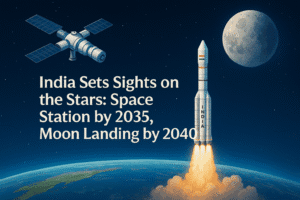India Sets Sights on the Stars: Space Station by 2035, Moon Landing by 2040
India has declared ambitious space goals: establishing its own Bharatiya Antariksh Station by 2035 and landing Indian astronauts on the Moon by 2040. Science Minister Jitendra Singh positioned these missions as critical milestones towards achieving a developed ‘Viksit Bharat’ by 2047. The announcement builds on national pride from Group Captain Subhanshu Shukla’s recent International Space Station mission. Singh highlighted a decade of transformative space reforms, including private sector participation fostering innovation and over 400 startups.
He emphasized space technology’s vital role in economic growth and practical applications like disaster management. While celebrating scientists’ achievements, the Minister noted disappointment with opposition protests during the parliamentary discussion. These targets signify India’s intent to join the elite ranks of spacefaring nations, demanding significant advancements in launch capability, life support, and deep space travel. Success would mark a defining leap in India’s technological sovereignty and global stature.

India Sets Sights on the Stars: Space Station by 2035, Moon Landing by 2040
India’s space ambitions have crystallized into concrete, ambitious timelines. Union Minister for Science and Technology, Dr. Jitendra Singh, has unequivocally declared the nation’s goals: an operational Bharatiya Antariksh Station (Indian Space Station) by 2035 and sending Indian astronauts to the Moon by 2040.
Announced during a special discussion in the Lok Sabha focused on space technology’s role in achieving a ‘Viksit Bharat’ (Developed India) by 2047, these targets represent a significant leap forward for the Indian Space Research Organisation (ISRO) and the country’s technological prowess.
Beyond Symbolism: Strategic Milestones
These aren’t merely aspirational dates; Minister Singh positioned them as critical steps preceding the broader 2047 development vision. Achieving them would:
- Establish India as a Leading Spacefaring Nation: Possessing its own space station places India in an elite global club, currently including only the US, Russia, China, and the multinational ISS partners. A crewed lunar mission further solidifies this status.
- Drive Technological Sovereignty: Developing the complex life support, orbital docking, deep space communication, and heavy-lift launch capabilities required for both missions will push Indian science and industry to new frontiers, fostering indigenous innovation.
- Catalyze Economic Growth: Minister Singh highlighted the space sector’s vital role in the economy. These mega-projects will generate high-tech jobs, spur advancements with terrestrial applications (materials science, robotics, communications), and boost the burgeoning private space ecosystem he mentioned. Over 400 Indian space startups are already emerging, fueled by reforms opening the sector.
- Inspire a Generation: Following the pride generated by Group Captain Subhanshu Shukla’s recent mission to the International Space Station (ISS), these ambitious national goals serve as powerful motivators for STEM education and national confidence.
Building on a Decade of Reform
Singh credited the acceleration of India’s space program to transformative changes over the past decade under Prime Minister Modi’s leadership:
- Opening the Sector: Liberalization allowing private participation has unleashed innovation and investment beyond ISRO.
- Startup Surge: A vibrant private space industry is now complementing ISRO’s efforts.
- Operational Impact: Space technology played a crucial role during critical events like Operation Ganga (referenced as “Operation Sindoor” – likely a transcription error), showcasing its practical utility.
- Enabling Development: From agriculture monitoring to disaster management and communication, space-derived data and services are increasingly integrated into national infrastructure and citizen services.
Acknowledging Achievement, Noting Discord
The Minister took a moment to laud Group Captain Shukla’s historic ISS mission, emphasizing the national pride it evoked. However, he also expressed disappointment at opposition MPs who protested during the discussion, failing to acknowledge the scientists and space experts behind India’s achievements.
The Road Ahead: Challenges and Opportunity
While the timelines are bold, they align with ISRO’s proven track record of cost-effective missions (Chandrayaan, Mangalyaan) and its developing capabilities (Gaganyaan human spaceflight program). Key challenges include:
- Securing sustained, significant funding.
- Developing next-generation launch vehicles (like the planned Next Generation Launch Vehicle – NGLV).
- Perfecting advanced life support and deep space survival systems.
- Maintaining rigorous testing and safety standards for human spaceflight.
Conclusion: A Defining Ascent
India’s declaration of intent for a 2035 space station and a 2040 crewed Moon mission is more than a headline; it’s a strategic national commitment. It signals a confident India leveraging space technology not just for exploration, but as a core engine for scientific advancement, economic growth, and global stature. The journey will demand immense effort, innovation, and collaboration between ISRO, private industry, and academia. If successful, it will mark a defining chapter in India’s ascent as a 21st-century technological powerhouse. The countdown to India’s next giant leaps has officially begun.
You must be logged in to post a comment.